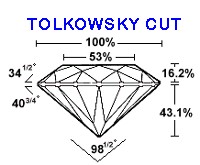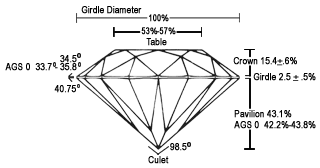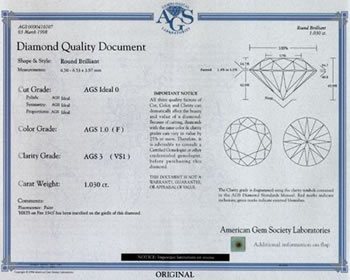Around 1900, improvements in diamond cutting tools such as diamond saws and lathes, make it possible for diamond cutters to take the next step in modern diamond cutting. In 1919, Marcel Tolkowsky used mathematical calculations to derive cut proportions to optimize brilliance and fire.
 The diamond cut proportions proposed by Tolkowsky are often labeled as being “ideal” and were the industry standard for decades. While the Tolkowsky cut (also known as the American Standard, American Ideal and Tolkowsky Brilliant) produce beautiful diamonds, the industry has known for years that diamonds cut to other proportions can be just as beautiful so the Tolkowsky parameters were not the only “ideal” cuts. In fact, Tolkowsky himself never used the word “ideal” in his “Diamond Design” publication. He used the phrases “best proportions,” “well-cut brilliant” and “high-class brilliant.” He also acknowledged that there was a much wider range of diamond proportions that yield “the liveliest fire and the greatest brilliancy.”
The diamond cut proportions proposed by Tolkowsky are often labeled as being “ideal” and were the industry standard for decades. While the Tolkowsky cut (also known as the American Standard, American Ideal and Tolkowsky Brilliant) produce beautiful diamonds, the industry has known for years that diamonds cut to other proportions can be just as beautiful so the Tolkowsky parameters were not the only “ideal” cuts. In fact, Tolkowsky himself never used the word “ideal” in his “Diamond Design” publication. He used the phrases “best proportions,” “well-cut brilliant” and “high-class brilliant.” He also acknowledged that there was a much wider range of diamond proportions that yield “the liveliest fire and the greatest brilliancy.”
The Tolkowsky brilliant cut specified proportions as follows:
- Table percentage – 53%
- Crown height percentage – 16.2%
- Pavilion depth percentage – 43.1%
- Crown angle – 34.5 degrees
- Pavilion angle – 40.8 degrees
Tolkowsky’s original publications assumed a “knife edge” girdle. Cutters knew they needed some girdle thickness for durability. As a result, they modified Tolkowsky’s original brilliant cut proportions to include girdle thickness as follows:
- Girdle percentage – 2.2%
- Depth percentage – 61.5% (crown + pavilion + girdle percentages)
The words “Tolkowsky Cut” appear on some diamond grading reports but you have to be careful not to be confused or misled. A grading report that includes the phrase “Tolkowsky Cut” does not necessarily mean that the diamond’s proportions have Tolkowsky’s exact specifications. Some laboratories like the European Gemological Laboratories (EGL) will state that a diamond is “Tolkowsky Cut” or within “Tolkowsky Range” if the diamond’s proportions are “within tolerance” of Tolkowsky’s original calculations. However, Tolkowsky never established these ranges or tolerances.
Old GIA Cut Classes
![]() In the 1950’s, the GIA published cut class parameters for round brilliant diamonds. The four cut classes, numbered 1 through 4, were often referred to as Ideal (1), Fine (2), Fair (3) and Poor (4). These cut classes were never included on the grading reports (certifications) but were utilized more for discussion purposes. In fact, the GIA often stated that there was no one set of parameters that always worked for cut and that the final determination of cut quality should be determined by a gemologist. Ironically, the training provided by GIA to gemologists contained no additional information or guidance on cut proportions. This effectively meant there were no gemologists with the definitive answers for what constitutes the best cut parameters.
In the 1950’s, the GIA published cut class parameters for round brilliant diamonds. The four cut classes, numbered 1 through 4, were often referred to as Ideal (1), Fine (2), Fair (3) and Poor (4). These cut classes were never included on the grading reports (certifications) but were utilized more for discussion purposes. In fact, the GIA often stated that there was no one set of parameters that always worked for cut and that the final determination of cut quality should be determined by a gemologist. Ironically, the training provided by GIA to gemologists contained no additional information or guidance on cut proportions. This effectively meant there were no gemologists with the definitive answers for what constitutes the best cut parameters.
| Lab | Gemological Institute of America (G.I.A.) | ||
| Cut > | Cut "1" | Cut "2" | Cut "3" |
| Table width % | 53 - 60 | 61 - 64 | 65 - 70 |
| Crown Height % | 13.5 - 16.5 | 11.5 - 13.5 | 9.0 - 11.0 |
| Crown Angle % | 34.0 - 35.0 | 32.0 - 34.0 | 30.0-32.0 |
| Pavilion Depth % | 43 | 42.0 - 44.0 | 41.0 - 46.0 |
| Pavilion Angle | 40.5 | 40.0 - 41.5 | 39.5 - 42.5 |
| Girdle Thickness | Medium to sl.Thick | Thin to Thick | Thin to Very thick |
| Total Depth% | 59.0-61.0 | 58.0 - 62.0 | Not Addressed |
| Culet size % | Not Addressed | Not Addressed | Not Addressed |
Old AGA System
 The Accredited Gem Appraisers (AGA) was the first national gem laboratory to offer a cut grade for round and fancy shaped diamonds. David S. Atlas is the President and head appraiser of this 100-year-old+ family firm. He oversees the varied business functions of D. Atlas & Co., Inc. and of this subsidiary, the AGA laboratory. He also heads the Accredited Gemologists Association, Accredited Gem Laboratory, which has operated at this same Philadelphia location for many years.
The Accredited Gem Appraisers (AGA) was the first national gem laboratory to offer a cut grade for round and fancy shaped diamonds. David S. Atlas is the President and head appraiser of this 100-year-old+ family firm. He oversees the varied business functions of D. Atlas & Co., Inc. and of this subsidiary, the AGA laboratory. He also heads the Accredited Gemologists Association, Accredited Gem Laboratory, which has operated at this same Philadelphia location for many years.
The AGA established a cut brilliance grading system in 1986 that classifies a diamond’s proportional cut into four categories (1 through 4), each with an A and B value. The resulting eight cut categories are as follows:
- AGA 1A and 1B – Ideal / Premium Cut
- AGA 2A and 2B – International Fine Cut
- AGA 3A and 3B – Domestic Average Cut
- AGA 4A and 4B – Below Average Cut
Accredited Gem Appraisers combined similar shapes together into four basic groups for determining cut grade.
- Round Brilliants
- Princess Cuts
- Emerald and Radiant Cuts
- Pear, Heart, Oval, Marquise Cuts
Because there are so many possibilities with fancy shaped diamonds, only the round brilliant shape was assigned parameters prior to 2002 for the 1A and 1B cut grades. In March of 2002, AGA introduced Ideal Cut (1A) and Premium Cut (1B) parameters for the major fancy shaped diamonds.
The AGA cut grades provide guidelines that optimize the brilliancy, fire and scintillation while avoiding stones that are small for the carat weight or have a durability concern. The top AGA cut grades target the best combinations of beauty and value in round and fancy shape diamonds.
The following chart shows the cut parameters for the top six AGA cut grades as they apply to round brilliant diamonds.
Old AGA Cut Grades – Round Diamonds
| Lab | Accredited Gem Appraisers (AGA) | |||||
| Cut > | 1A | 1B | 2A | 2B | 3A | 3B |
| Table width % | 53.0 - 58.0 | 52.0 - 60.0 | 51.5 - 63.0 | 51.0 - 64.0 | 50.5 - 67.0 | 50.0 - 70.0 |
| Crown Height % | 14.3 - 16.3 | 13.5 - 16.8 | 11.6 - 17.9 | 11.1 - 18.1 | 9.6 - 19.3 | 8.5 - 50.5 |
| Crown Angle | 34.3 - 34.8 | 34.2 - 35.0 | 32.1 - 35.8 | 31.6 - 36.4 | 30.1 - 37.9 | 29.6 - 39.4 |
| Pavilion Depth % | 42.8 - 43.2 | 42.7 - 43.5 | 42.4 - 44.0 | 41.9 - 44.9 | 41.4 - 45.5 | 40.9 - 46.0 |
| Pavilion Angle | Not Addressed | Not Addressed | Not Addressed | Not Addressed | Not Addressed | Not Addressed |
| Girdle Thickness | Thin to Med or Med to Sl. Thick | Very Thin to Med or Med to Sl. Thick | Very Thin to Sl. Thick | Very Thin to Thick | Very Thin to Very Thick | Very Thin to Very Thick |
| Total Depth% | 58.7 - 62.3 | 58.3 - 62.9 | 57.9 - 63.5 | 57.5 - 63.8 | 57.0 - 64.1 | 56.5 - 65.0 |
| Culet size % | Pointed to Med | Pointed to Sl. Large | Pointed to Sl. Large | Pointed to Large | Pointed to Large | Pointed to Large |
Old AGS Cut Grades
 In 1996, the American Gemological Society (AGS) Laboratory first introduced cut grades on their certifications. They had a grading scale of 0-10 with “zero cut” labeled Ideal. The AGS used the term Ideal to identify their top grade for polish, symmetry and proportions. To get a “0-cut” grade, the diamond had to have specifications falling in the following ranges:
In 1996, the American Gemological Society (AGS) Laboratory first introduced cut grades on their certifications. They had a grading scale of 0-10 with “zero cut” labeled Ideal. The AGS used the term Ideal to identify their top grade for polish, symmetry and proportions. To get a “0-cut” grade, the diamond had to have specifications falling in the following ranges:

The following chart shows the old AGS cut grade parameters for round brilliant diamonds.
Old AGS Cut Grade Parameters
| Lab | American Gem Society (A.G.S.) | ||||
| Cut > | Cut "0" | Cut "1" | Cut "2" | Cut "3" | Cut "4" |
| Table width % | 52.4 - 57.5 | 51.4 -59.5 | 51.4 - 61.5 | 50.4 - 63.5 | 50.4 - 65.5 |
| Crown Height % | 14.5 - 16.5 | 14.0 - 17.5 | 12.5 - 18.0 | 11.5-19.0 | 10.5 - 19.5 |
| Crown Angle % | 33.7 - 35.8 | 32.7 -36.3 | 32.2 - 36.8 | 31.7 - 37.3 | 31.2 - 37.8 |
| Pavilion Depth % | 42.2 - 43.8 | 42.2 - 44.3 | 41.7 - 44.8 | 41.7 - 44.8 | 41.2 - 45.3 |
| Pavilion Angle | 40.2 - 41.5 | 40.2 - 41.5 | 39.7 - 42.0 | 39.7 - 42.0 | 39.7 - 42.3 |
| Girdle Thickness | Thin to sl. Thick 0.51 - 2.95% |
Very thin to sl. Thick 0.091 - 2.95% |
Very thin to sl. Thick 0.091 - 2.95% |
Very thin to Thick 0.091 - 4.20% |
Very Thin to Thick 0.091 - 4.20% |
| Total Depth% | Not Addressed | Not Addressed | Not Addressed | Not Addressed | Not Addressed |
| Culet size % | Pointed to Med | Pointed to sl. Large | Pointed to sl. Large | Pointed to Large | Pointed to Large |
New AGS Cut Grades
On June 1st 2005, the AGS implemented a new cut grade system which added Light Performance as a key cut criteria. The new AGS cut grade system rated diamonds on three criteria.
1) Light Performance including Brightness, Fire (dispersion), Leakage and Contrast
2) Proportions including Girdle Thickness, Culet Size, Size Relative to Weight, Durability and Tilt
3) Finish including Polish and Symmetry
Whereas the old system relied primarily on physical specifications of the diamond, the new system put the emphasis on how the diamond actually handled light. This resulted in some diamonds dropping several cut grades and others increasing in cut grade compared to the old system. For example, the AGS’s new cut grade system now allows table percentages up to 61% for their top cut grade. The old AGS system was limited to the 53-57% range for table percentages. The new AGS cut grade can only be determined using AGS hardware and software so can no longer be determined based on numbers alone.
New GIA Cut Grade System
In January of 2006, the GIA introduced their new cut grade system that measures eleven parameters of a round diamond and computes a cut grade. The GIA cut grade categories are: Excellent, Very Good, Good, Fair and Poor. It is important to note that there is no use of the term “ideal” in the GIA cut grade system.
The new GIA cut grade system no longer has defined ranges for the parameters. Instead, the cut grade is determined by software that takes into account the three-dimensional aspects of a diamond. The cut grade is dependent on how the various components relate to each other rather than having all the parameters fall within a specific range.
While the new GIA system is based on research on over 70,000 diamond observations (people looking at diamonds), the resulting system is measurement based rather than how a diamond actually performs in light.
One of the most noticeable changes in the GIA’s cut grade system is that the maximum table percentage allowed for an Excellent cut is now up to 62%, a significant increase from the 53-60% range for the old GIA class 1 cut.
For round brilliant diamonds graded by the GIA since January 1st 2006, the GIA cut grade is printed on the Diamond Grading Report or Diamond Dossier Report. For round brilliant diamonds graded by the GIA in 2005, the cut grade was not printed on the grading reports but the necessary data was collected and the cut grade is available online at www.GIA.edu/reportcheck by inputting the grading report number and carat weight of the diamond.
GIA – AGS Comparison
As cut research continues, we expect to see the GIA and AGS continue to revise their cut grade systems but a logical question for the diamond shopper is how the two cut grade systems compare today.
While the GIA has taken a positive step forward by including a cut grade on their grading reports, their cut categories are very broad and not necessarily consistent with optimal light performance. There are now diamonds with the GIA’s Excellent cut grade that have lower light performance than some diamonds in the Very Good cut grade. Sometimes this is due to minor characteristics dropping a diamond to Very Good even though they are beautiful diamonds with exceptional brightness, fire and scintillation. On the flip side, diamonds that use to be in the old GIA cut class 3 can now have a Very Good cut grade, but not be close to the beauty of other diamonds in that cut grade.
We feel the AGS cut grades are more accurate in corresponding to light performance that creates the beauty of the diamond. However, the fact that the AGS cut grade can only be determined using expensive and exclusive hardware and software means the diamond shopper is limited to AGS graded diamonds for the AGS cut grade. With the AGS representing such a small percentage of diamonds on the market, this limits the selection to the diamond shopper who would like to use the AGS cut grades.
Because neither of the new cut grade systems uses specific ranges for proportions, it is not easy to compare the two systems. The AGS system measures actual light performance while the GIA system is a predictive model.
Visual Differences between Ideal Cuts
A frequently asked question from our clients is “Can you see a difference between the top cut grades from GIA and AGS?” Most diamond shoppers can see the difference in light performance when comparing “average” cuts with “ideal” cuts because diamonds with better cut have more sparkle and brightness. However, we find the visual difference between the AGS Ideal (Ideal polish, symmetry proportions and light performance) compared to the GIA Excellent (Excellent polish, symmetry and cut) is extremely small, if any. What tends to be more visible when comparing diamonds, is the lighting and viewing conditions.
While neither the GIA nor the AGS has any rating or grade for Hearts & Arrows (pattern symmetry), we find this is one area with visible differences. While few diamonds on the market today would qualify as true Hearts and Arrows by original Japanese standards, we find that diamonds that display some type of Hearts and Arrows pattern, especially a sharp and uniform pattern, are usually visually superior.
